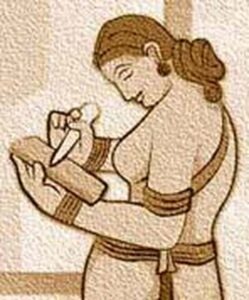She was a female Indian Yogini, philosopher and seer. Her legends are eminent in the ancient Vedic period scriptures. She suffered from a skin ailment when she was very young, which led to her disfiguration. Due to this, she had to stay a maiden for a long time. Later when her ailment was cured, she got married and was blessed with a son.

Proficient in the Vedas, she even scripted two hymns in the Rigveda. Gosha was also known as “mantradrika” , which means well versed in mantras. She was also referred as “Brahmavadini” which means speaker or proclaimer of Brahmana. She led a purposeful spiritual life.
Story Behind Her Marriage:
Born in India during the Vedic period, Gosha’s father was a Kakshivat and her grandfather was a Dirghatama. They both have contributed hymns in the Rigveda.
When she was quite young, Gosha suffered from a skin ailment, due to which she was confined to the house attending to her father. She had leprosy, as stated in a hymn, disfiguring her. This caused her to lead an unmarried life for quite a long time until she fervently meditated on the Ashvins. They were twins, and divine physicians of the time, mastering the art of rejuvenation. In the Rigveda, Ashvins are mentioned as the youthful and divine twin horsemen, travelling in a horses chariot, that are never weary or tired; and described as guardian deities that protect and rescue people by helping them in various situations.
They taught Gosha, the Vedic education of Madhu Vidhya, a secret science to restore youth and gain great knowledge, to cure her from the disease of leprosy. Her constant meditation made Ashvin Kumars’ cure her of her ailment and regain her beauty.
Because of this blessing, she then got married and had a son named Suhstya. He also composed a hymn in the Rigveda.
Hymns—Praise Of the Ashvins:
Ashvini Kumars plays a crucial role in Gosha’s life. She composed two hymns in their praise. These are mentioned in the tenth Mandala (book) of the Rigveda (chapter X—hymns 39 and 40, each containing 14 verses).
The first hymn is in the praise of the Ashvins. The second, is about her own expression of desire for marriage.
The Two Hymns:
Ashvins your radiant Chariot- whither goes it on its way?
Who decks it for you, Heroes, for its happy course starting at day break visiting each morning every house, borne hitherward through prayer unto the sacrifice?

Where are you Ashvins, in the evening, where in the morning? Where is your halting place, where do you rest for the night? O’ Heroes, this I beg of you.
“Be near me in the day, be near me at night.”
Conclusion:
We have several instances throughout ancient Indian history and references in religious scriptures to prove that feminism as we know it today existed back in the Vedic ages.
Women were empowered to study religion and become Rishikad or Sadhvis. They even composed Vedic hymns and practiced medicine.
Indian Vedic times was truly a golden era, which got lost in orthodoxy and fanaticism. We should revive our heritage and emulate it.
Interested in becoming a yoga teacher?
Newsletter
Upcoming events and latest blogs